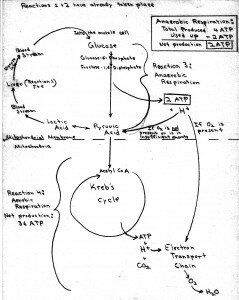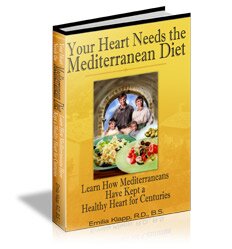 I was going through some storage bins over the weekend and came across this crazy drawing of energy production you see on the left. It’s from my biochemistry class in college, and it has a direct application to cardiovascular health. In fact, once you understand it you will realize how important good circulation is to your health and your ability to produce energy.
I was going through some storage bins over the weekend and came across this crazy drawing of energy production you see on the left. It’s from my biochemistry class in college, and it has a direct application to cardiovascular health. In fact, once you understand it you will realize how important good circulation is to your health and your ability to produce energy.
It looks pretty confusing but let me help you understand it by asking you a very simple question:
If You Had a Stock Option That Paid You a Return of 2% or 36% Which Would You Choose?
Every person I’ve ever asked this question to always chooses 36%. Why? Because it returns a higher yield. Well, this is the difference in energy production between anaerobic respiration and aerobic respiration.
Anaerobic Respiration – Energy Production Without Oxygen!
The top half of this drawing represents the energy production achieved by anaerobic respiration. As your blood filters through the liver, glucose (blood sugar) is added to your blood stream. This is carried to your cells to be converted into energy. When your cell lacks oxygen it uses a chemical process called anaerobic respiration to convert the glucose into energy. It’s extremely inefficient and the net result is just 2 units of energy.
Plus it produces a byproduct called pyruvic acid. If oxygen is not present then the cell converts this pyruvic acid to lactic acid. This allows the cell to continue to produce a small quantity of energy. However, lactic acid is an irritant. It causes that burning sensation you feel when you’ve overused a muscle and it interferes with proper cell function.
The net result of anaerobic respiration is poor energy production and a large amount of waste material that disrupts the proper function of the cells, tissues, and organs.
Aerobic Respiration – Energy Production With Oxygen!
When oxygen is present the pyruvic acid will enter the mitochondria of your cells to be used in the Kreb’s cycle. (If you think this drawing is confusing and crazy you should see the drawing for the Kreb’s cycle.) Think of your mitochondria as an energy producing factory.
This process will take that one unit of glucose and convert it into 36 units of energy. This is 18 times more productive than anaerobic respiration. Plus, the waste products are carbon dioxide and water. You breath out carbon dioxide and you eliminate any excess water. Neither of these two waste products damage your cells, tissues, and organs.
While aerobic respiration can cause oxidative stress to cells, the net result is large energy production with waste material that is not disruptive to the proper functioning of your cells, tissues, and organs.
Government versus Private Sector
Some have even compared this process of energy production to the difference between government run programs and private sector programs. Anaerobic respiration, like the government, is very inefficient and produces only a small return on investment; 1 unit of glucose yields 2 units of energy with bureaucratic red tape that can clog and slow down the system.
Aerobic respiration, like the private sector, is very efficient and produces a large return on investment; 1 unit of glucose yields 36 units of energy with an assembly line that is highly productive but also needs proper maintenance to continue its accelerated production.
What Does All This Have To Do With Cardiovascular Health?
Your red blood cells carry oxygen to your tissues and cells. If your cardiovascular system is damaged by cholesterol, excess sugar that causes oxidative stress, plaque formations, and other contributing factors, then you begin to limit blood flow. This damage limits the delivery of oxygen and causes your cells to depend more on anaerobic respiration for their energy needs.
Because anaerobic respiration can’t keep up with the needs of the cells, the cells have to slow down. They become less efficient and sluggish in their job. Compound this with the waste products produced from anaerobic respiration and you have a cycle that leads to poor organ health and poor overall wellness.
The Key to Reversing This Cycle!
The key to reversing this degenerating cycle is to improve blood circulation by repairing the damage caused to the endothelial cells that line all of your cardiovascular system. As you improve the health of your endothelial cells they are able to properly produce nitric oxide. Nitric oxide is the master signaling molecule of the cardiovascular system. This means that nitric oxide is needed to properly regulate blood flow to the cells, tissues, and organs.
This dramatically improves blood flow, which then delivers more oxygen. More oxygen produces more energy and waste products that are easily transported away from the cells, tissues, and organs. The net result is improved organ function, improved energy, and a higher level of overall wellness.
By properly combining the amino acids L-arginine and L-citrulline with key antioxidants you can repair your endothelial cells and improve their ability to create nitric oxide. This has been clinically shown to improve circulation and reverse many cardiovascular health issues. It’s what makes the ProArgi-9 Plus product so effective in helping people improve their energy production and cardiovascular health.
It’s pretty amazing how improved blood flow to all your cells, tissues, and organs can make such a significant difference in your overall health. But, there is still one other factor we need to address. That factor is the need for antioxidants to help protect your cells when oxygen is used to create all this wonderful energy. We’ll talk about this in my next post.
Together we can work to save a million lives!
Dan Hammer
Dan Hammer is a Wellness Educator who has a background in biology, chemistry and exercise physiology. He used to run one of the largest health club operations in the Chicago area and has been helping people with their wellness issues for more than 25 years.




Energy Production and Cardiovascular Health! | No More Heart Disease…
I found your entry interesting do I’ve added a Trackback to it on my weblog …
…
[...] will produce 36 units of energy and the resulting waste products are carbon dioxide and water. Aerobic respiration produces 18 times more energy and its waste products do not negatively affect muscle contraction like lactic acid does. Yet, the [...]